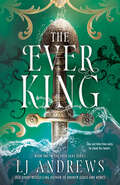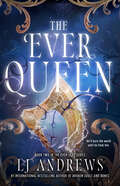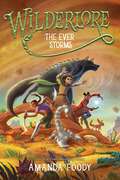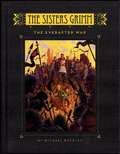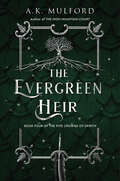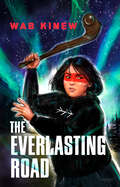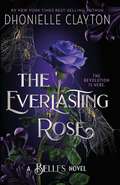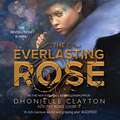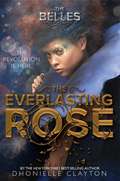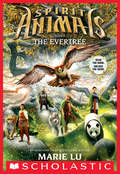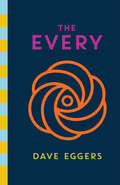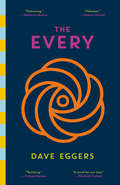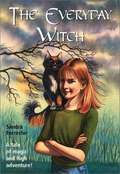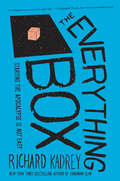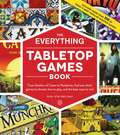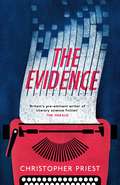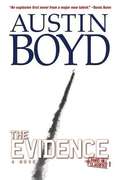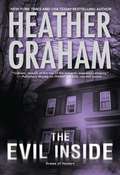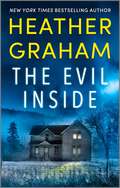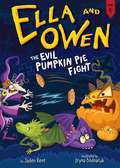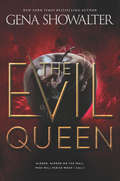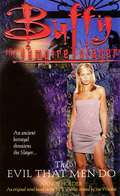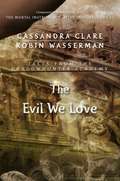- Table View
- List View
The Ever King (The Ever Seas)
by LJ AndrewsThe first in the TikTok sensation Ever Seas series, now with bonus material!They stole his crown. So he stole their daughter....For years, Erik, the scarred king of the Ever Kingdom, has thought of nothing but vengeance against the man who killed his father and trapped him beneath the waves, making him a prisoner in his own realm.Until his enemy&’s daughter unintentionally breaks the chains on the Ever, and Erik makes her the unwitting pawn in his vicious game of revenge.She&’s innocent. He&’s vicious. But he will take back what he lost, no matter the price.Unless she steals his heart first.
The Ever Queen (The Ever Seas)
by LJ AndrewsThe second in the TikTok sensation Ever Seas series, now with bonus material!With his queen missing, the king&’s wrath knows no boundaries.Captive. Challenger. Queen.Enemies took her from the man who holds her heart. They might see her as weak, as a pawn in wicked games, but they&’re no match for the first Ever Queen.Let them think they&’ve won. Her heart belongs to a beautiful monster, and she will never stop fighting until she&’s back in his arms.Captor. Villain. King.They&’ll die for touching her.His heart belongs to a stunning little bird. He will never stop searching for her light across the skies. Not until the blood of his enemies spills at her feet, and his queen wears their bones around her neck.
The Ever Storms (Wilderlore #3)
by Amanda FoodyBarclay and his friends find new dangers and fresh adventure when they encounter mysterious sandstorms in the Desert in this &“engaging, dragon lover&’s fantasy&” (School Library Journal) that&’s the third book of the New York Times bestselling Wilderlore series.After saving the Sea, Barclay and his fellow apprentices are eager to take part in a new kind of adventure—the Symposium, a set of courses that all apprentices of the Lore Keeper Guild need to pass before they can take their licensing exam. Barclay is excited to travel to the Desert to study at the University of Al Faradh, the most respected school in all the Wilderlands, and to reunite with the new friends he made at the Sea. He&’s slightly less excited about the Tourney, the traditional, good-natured prank war between the various apprentice tracks. As an Elsie, he&’s pretty sure he&’ll have enough on his hands keeping up with the Symposium without having to worry about stink bombs and slime warfare. But as mysterious, unnatural sandstorms start to appear around the Desert, there are more than just exams and bragging rights at stake. And the appearance of an exclusive, magical library might just be the key to everything…
The Everafter War (The Sisters Grimm Book #7)
by Michael BuckleySabrina and Daphne's prayers are finally answered when their parents finally wake up from their sleeping spell. Their happy reunion is short-lived, as they are caught in the middle of a war and shocking secrets are revealed.
The Evergreen Heir: A Novel (The Five Crowns of Okrith #4)
by A.K. MulfordFrom bestselling author and TikTok sensation A.K. Mulford comes the fourth book in the Five Crowns of Okrith fantasy series, following a bookish heir’s fight to save their mother and kingdom when an unexpected romance blossoms. The crown is calling their name, yet can their head bear the weight when passion sets hearts racing? Perfect for fans of Sarah J. Maas, Sue Lynn Tan, and Jennifer L Armentrout.A court of revelry. A bookish heir. An impending marriage. And a dark new power rising in the world…If allowed, Neelo Emberspear would never leave the library. Reluctant to take the throne despite their mother’s faltering health, the neurodivergent bookworm craves escape from their arranged marriage to charming fae warrior Talhan Catullus. But they know their duty can be put off no longer when their mother, the drug-addled queen, disastrously lights the castle on fire.Fighting to save their mother’s life and keep her on the throne, Neelo is astonished when bonding over the written word brings them closer than ever to their cavalier, soon-to-be husband. But the non-binary heir’s growing affections may be cut short with witch uprisings threatening to topple the entire continent. Can Neelo claim both love and dominion before their court is reduced to ash?
The Everlasting Road (The Floraverse)
by Wab KinewThe boundaries between the virtual and the real world become dangerously blurred for a young Indigenous girl in the follow-up to the YA fantasy debut Walking in Two Worlds from bestselling Indigenous author Wab Kinew. Perfect for fans of Ready Player One and the Otherworld series. Devastated by the loss of her beloved older brother to cancer, Bugz returns to the place where she can always find solace and strength: the Floraverse. Over the past year, she has gained back all that she had lost in that virtual world, and while the remaining ClanLess members still plot against her, she is easily able to overcome their attacks. Even better, she's been secretly working on a bot that will be both an incredible weapon and a source of comfort: Waawaate. With the Waawaate bot looking exactly like the brother she misses so much — even acting so much like him — Bugz feels ready to show him off to Feng, who has become a constant companion in the Verse, and she cannot wait to team up with both friend and bot to secure her dominance once and for all. But Feng has his own issues to deal with, especially when news that his parents are alive and want to contact him threatens to send his new life on the Rez into upheaval. As they work through their complicated feelings of grief and loss, Feng and Bugz find themselves becoming ever closer. But disturbances in the Floraverse cannot be ignored, especially when Bugz realizes that her Waawaate bot is growing in powers beyond her control . . .
The Everlasting Rose
by Dhonielle ClaytonThe dazzling sequel to the New York Times bestselling THE BELLES from the author of TINY PRETTY THINGS (coming to Netflix soon)The Belles control beauty.All our lives, my sisters and I have served the people of Orleans.For years, they've held their abilities against us. Not anymore.Now the queen hunts us for what we know about the rightful heir.They murdered our princess and fled the city. The princess is still alive, and we'll help her take back the throne.They'll return and give us what we deserve: beauty, everlasting. We will demand our freedom. No matter what the cost.Praise for THE BELLES:'Heart-pounding' Samantha Shannon, New York Times bestselling author'Diverse' Tomi Adeyemi, #1 New York Times bestselling author'Whipsmart' Roxane Gay, New York Times bestselling author'Groundbreaking' Rick Riordan, #1 New York Times bestselling author'Unsettling' Marie Lu, #1 New York Times bestselling author'Immersive' Renée Ahdieh, #1 New York Times bestselling author'Badass' Adam Silvera, New York Times bestselling author'Intoxicating' Kami Garcia, #1 New York Times bestselling author'Frightening' Marie Rutkoski, New York Times bestselling author
The Everlasting Rose
by Dhonielle ClaytonThe dazzling sequel to the New York Times bestselling THE BELLES from the author of TINY PRETTY THINGS (coming to Netflix soon)The Belles control beauty.All our lives, my sisters and I have served the people of Orleans.For years, they've held their abilities against us. Not anymore.Now the queen hunts us for what we know about the rightful heir.They murdered our princess and fled the city. The princess is still alive, and we'll help her take back the throne.They'll return and give us what we deserve: beauty, everlasting. We will demand our freedom. No matter what the cost.Praise for THE BELLES:'Heart-pounding' Samantha Shannon, New York Times bestselling author'Diverse' Tomi Adeyemi, #1 New York Times bestselling author'Whipsmart' Roxane Gay, New York Times bestselling author'Groundbreaking' Rick Riordan, #1 New York Times bestselling author'Unsettling' Marie Lu, #1 New York Times bestselling author'Immersive' Renée Ahdieh, #1 New York Times bestselling author'Badass' Adam Silvera, New York Times bestselling author'Intoxicating' Kami Garcia, #1 New York Times bestselling author'Frightening' Marie Rutkoski, New York Times bestselling author
The Everlasting Rose (The Belles #2)
by Dhonielle ClaytonIn this sequel to the New York Times bestselling novel, The Belles, Camellia Beaureguard, the former favorite Belle, must race against time to find the ailing Princess Charlotte, who has disappeared without a trace. The evil queen Sophia's imperial forces will stop at nothing to keep Camille, her sister Edel, and her loyal guard, Rémy, from returning Charlotte to the palace and her rightful place as queen. With the help of an underground resistance movement called the Iron Ladies--a society that rejects beauty treatments entirely--and the backing of alternative newspaper the Spider's Web, Camille uses her powers, her connections, and her cunning to outwit her greatest nemesis, Sophia, and attempt to restore peace to Orléans. But enemies lurk in the most unexpected places, forcing Camille to decide just how much she's willing to sacrifice to save her people.
The Evertree: The Evertree (Spirit Animals #7)
by Marie LuEverything comes to a head in this seventh book in the NEW YORK TIMES bestselling series. The world of Erdas will be changed forever.Conor, Abeke, Meilin, and Rollan were once ordinary kids. Then they discovered that they had spirit animals-wise and powerful partners who granted them with amazing gifts . . . and a legendary responsibility. Together, the team has journeyed across Erdas, racing to stop a merciless foe. They have laughed and fought together. They've won challenges and lost friends. Some have even lost themselves.Now that journey is about to end. They must reach a place forgotten by time and face off against an ancient enemy breaking free from his prison. They have just one chance to stop him . . . or the whole world will shatter.
The Every: A novel
by Dave EggersFrom the award-winning, bestselling author of The Circle comes an exciting new follow-up. When the world&’s largest search engine/social media company, The Circle, merges with the planet&’s dominant e-commerce site, it creates the richest and most dangerous—and, oddly enough, most beloved—monopoly ever known: The Every. Delaney Wells is an unlikely new hire. A former forest ranger and unwavering tech skeptic, she charms her way into an entry-level job with one goal in mind: to take down the company from within. With her compatriot, the not-at-all-ambitious Wes Kavakian, they look for the company&’s weaknesses, hoping to free humanity from all-encompassing surveillance and the emoji-driven infantilization of the species. But does anyone want what Delaney is fighting to save? Does humanity truly want to be free? Studded with unforgettable characters and lacerating set pieces, The Every blends satire and terror, while keeping the reader in breathless suspense about the fate of the company—and the human animal.
The Every: A novel
by Dave EggersFrom the award-winning, bestselling author of The Circle comes an exciting new follow-up. When the world&’s largest search engine/social media company, the Circle, merges with the planet&’s dominant ecommerce site, it creates the richest and most dangerous—and, oddly enough, most beloved—monopoly ever known: the Every.Delaney Wells is an unlikely new hire at the Every. A former forest ranger and unwavering tech skeptic, she charms her way into an entry-level job with one goal in mind: to take down the company from within. With her compatriot, the not-at-all-ambitious Wes Makazian, they look for the Every's weaknesses, hoping to free humanity from all-encompassing surveillance and the emoji-driven infantilization of the species. But does anyone want what Delaney is fighting to save? Does humanity truly want to be free? Studded with unforgettable characters, outrageous outfits, and lacerating set-pieces, this companion to The Circle blends absurdity and terror, satire and suspense, while keeping the reader in apprehensive excitement about the fate of the company—and the human animal.
The Everyday Witch
by Sandra ForresterOn the eve of her twelfth birthday, Beatrice Baily is surprised to find that the decision about her classification as a witch has not been made and that she must first perform a task involving the evil Dally Rumpe.
The Everything Box: A Novel
by Richard KadreyReminiscent of the edgy, offbeat humor of Chris Moore and Matt Ruff, the first entry in a whimsical, fast-paced supernatural series from the New York Times bestselling author of the Sandman Slim novels--a dark and humorous story involving a doomsday gizmo, a horde of baddies determined to possess its power, and a clever thief who must steal it back . . . again and again. 22000 B.C. A beautiful, ambitious angel stands on a mountaintop, surveying the world and its little inhabitants below. He smiles because soon, the last of humanity who survived the great flood will meet its end, too. And he should know. He's going to play a big part in it. Our angel usually doesn't get to do field work, and if he does well, he's certain he'll get a big promotion.And now it's time . . . .The angel reaches into his pocket for the instrument of humanity's doom. Must be in the other pocket. Then he frantically begins to pat himself down. Dejected, he realizes he has lost the object. Looking over the Earth at all that could have been, the majestic angel utters a single word. "Crap." 2015. A thief named Coop--a specialist in purloining magic objects--steals and delivers a small box to the mysterious client who engaged his services. Coop doesn't know that his latest job could be the end of him--and the rest of the world. Suddenly he finds himself in the company of The Department of Peculiar Science, a fearsome enforcement agency that polices the odd and strange. The box isn't just a supernatural heirloom with quaint powers, they tell him. It's a doomsday device. They think . . . And suddenly, everyone is out to get it.
The Everything Box: A Novel
by Richard KadreyReminiscent of the edgy, offbeat humor of Chris Moore and Matt Ruff, the first entry in a whimsical, fast-paced supernatural series from the New York Times bestselling author of the Sandman Slim novels--a dark and humorous story involving a doomsday gizmo, a horde of baddies determined to possess its power, and a clever thief who must steal it back . . . again and again.22000 B.C. A beautiful, ambitious angel stands on a mountaintop, surveying the world and its little inhabitants below. He smiles because soon, the last of humanity who survived the great flood will meet its end, too. And he should know. He's going to play a big part in it. Our angel usually doesn't get to do field work, and if he does well, he's certain he'll get a big promotion.And now it's time . . . .The angel reaches into his pocket for the instrument of humanity's doom. Must be in the other pocket. Then he frantically begins to pat himself down. Dejected, he realizes he has lost the object. Looking over the Earth at all that could have been, the majestic angel utters a single word."Crap."2015. A thief named Coop--a specialist in purloining magic objects--steals and delivers a small box to the mysterious client who engaged his services. Coop doesn't know that his latest job could be the end of him--and the rest of the world. Suddenly he finds himself in the company of The Department of Peculiar Science, a fearsome enforcement agency that polices the odd and strange. The box isn't just a supernatural heirloom with quaint powers, they tell him.It's a doomsday device. They think . . .And suddenly, everyone is out to get it.
The Everything Tabletop Games Book: From Settlers of Catan to Pandemic, Find Out Which Games to Choose, How to Play, and the Best Ways to Win! (Everything®)
by BeboTabletop and board games aren’t just for rainy days or awkward family events anymore. As the game industry grows, people of all ages are jumping to play “the original social network.”In our ever-increasing technological world, playing old-school games is a welcome retreat from the overexposure to Instagram, Twitter, Facebook, and the rest of social media. Over the past few years, board games have become the hot new hobby. Instead of friends sitting around the same table and staring at their phones, they are now either working with or against each other. Millions upon millions of new fans have begun to join their friends in real life for a fun game of Pandemic, 7 Wonders, or Ticket to Ride. The Everything Tabletop Games Book shows how to play some of the best tabletop games in the world, from classic strategy games like Settlers of Catan to great new games like Gloomhaven. Throughout the book, you’ll learn the different genres of tabletop and board games; how to play each game; rules and strategies to help you win; and even where to play online—including new expansions to keep your favorite games fresh and exciting. So gather up some friends, pick a game from this book, and start playing! You’ll be having a blast in no time.
The Evidence
by Christopher PriestTodd Fremde is an author, a writer of police procedurals and criminal mysteries. Invited to the remote island of Dearth, far across the Dream Archipelago, to talk at a conference, he finds himself caught up in a series of mysteries. How can Dearth claim to be completely crime-free, yet still have an armed police force? Why are they so keen for him to appear, but so dismissive when he arrives? Is his sense of time confused, or is something confusing happening to time itself?And how does this all connect with a murder committed on his home island, ten years before, and seemingly forgotten? Fremde's investigation and research will lead him to some dangerous conclusions...Christopher Priest is a genre-leading author of SFF fiction. His novel, THE PRESTIGE, won a number of awards and was adapted into a critically acclaimed, Oscar-nominated film directed by Christopher Nolan (TENET, INCEPTION) starring Hugh Jackman (THE GREATEST SHOWMAN, X-MEN), Christian Bale (THE BIG SHORT, BATMAN BEGINS), Michael Caine (THE ITALIAN JOB) and Scarlett Johansson (MARRIAGE STORY, THE AVENGERS).
The Evidence
by Christopher PriestTodd Fremde is an author, a writer of police procedurals and criminal mysteries. Invited to the remote island of Dearth, far across the Dream Archipelago, to talk at a conference, he finds himself caught up in a series of mysteries. How can Dearth claim to be completely crime-free, yet still have an armed police force? Why are they so keen for him to appear, but so dismissive when he arrives? Is his sense of time confused, or is something confusing happening to time itself?And how does this all connect with a murder committed on his home island, ten years before, and seemingly forgotten? Fremde's investigation and research will lead him to some dangerous conclusions...Christopher Priest is a genre-leading author of SFF fiction. His novel, THE PRESTIGE, won a number of awards and was adapted into a critically acclaimed, Oscar-nominated film directed by Christopher Nolan (TENET, INCEPTION) starring Hugh Jackman (THE GREATEST SHOWMAN, X-MEN), Christian Bale (THE BIG SHORT, BATMAN BEGINS), Michael Caine (THE ITALIAN JOB) and Scarlett Johansson (MARRIAGE STORY, THE AVENGERS).
The Evidence (Mars Hill Classified, Book #1)
by Austin BoydAfter waiting his entire life to become an astronaut, John Wells's nearly realized dream is turning into a nightmare. As the nation's capital comes under intense terrorist attack and signs of sophisticated alien life mysteriously appear on the Internet, Wells finds himself increasingly entangled in a web of global deceit---with his marriage, his life, and the planet on the line!
The Evil Inside (Krewe of Hunters #4)
by Heather GrahamSome deaths live on forever. For as long as it has stood overlooking New England's jagged coastline, Lexington House has been the witness to madness... and murder. But in recent years the inexplicable malice that once tormented so many has lain as silent as its victims. Until now...A member of the nation's foremost paranormal forensic team, Jenna Duffy has made a career out of investigating the inexplicable. Yet nothing could prepare her for the string of slayings once again plaguing Lexington House-or for the chief suspect, a boy barely old enough to drive, much less kill.With the young man's life on the line, Jenna must team up with attorney Samuel Hall to pinpoint who--or what--is taking the lives of those who get too close to the past. But everything they learn brings them closer to the forces of evil stalking this tortured ground.
The Evil Inside: Phantom Evil, Heart Of Evil, Sacred Evil, The Evil Inside (Krewe of Hunters #4)
by Heather GrahamDelve into the haunting mystery and explore the history of Salem in this chilling suspense from New York Times bestselling author Heather Graham.For as long as it has stood overlooking New England’s jagged coastline, Lexington House has been the witness to madness…and murder. But in recent years the inexplicable malice that once tormented so many has lain as silent as its victims. Until now…A member of the nation’s foremost paranormal forensic team, the FBI’s Krewe of Hunters, Jenna Duffy has made a career out of investigating the inexplicable. Yet nothing could prepare her for the string of slayings once again plaguing Lexington House—or for the chief suspect, a boy barely old enough to drive, much less kill.With the young man’s life on the line, Jenna must team up with attorney Samuel Hall to pinpoint who—or what—is taking the lives of those who get too close to the past. But everything they learn brings them closer to the forces of evil stalking this tortured ground.Previously published
The Evil Pumpkin Pie Fight! (Ella and Owen #4)
by Jaden KentIn this fourth book in the Ella and Owen series, the dragon siblings run up against an evil pumpkin king, a hungry spider, and a witch. On top of that, they have to deal with an army of pumpkins that want to fight with pie, when all the twins really want to do is get home without getting lost.As the fourth book in the Ella and Owen series begins, Ella's sense of adventure gets the twins in trouble--yet again! The siblings are stuck outside at night, unsure of where they are, when a light in the distance intrigues Ella. The two end up meeting an evil pumpkin king, traveling through a graveyard to meet with a witch, and getting caught in a spider's web. In order to get a map from the pumpkin king so they can find their way home, they even have to help an army of pumpkins fight the witch! Just in time for Halloween, this new addition to the fun dragon-y series has lots of spooky, scary bits while being filled with non-stop action and silliness.This early chapter book series has it all--humor, adventure, a dash of some gross-out stuff, and just the right mixture of sibling rivalry/love. Black and white illustrations with dragon details galore on every page add to the enjoyment, making Ella and Owen's world pop on each page.
The Evil Queen (The Forest of Good and Evil #1)
by Gena ShowalterWELCOME TO THE FOREST OF GOOD AND EVIL.A DREAM COME TRUE…AND A LIVING NIGHTMARE. <P><P>Far, far away, in the realm of Enchantia, creatures of legend still exist, magic is the norm and fairy tales are real. <P><P>Except, fairy tales aren’t based on myths and legends of the past—they are prophecies of the future.Raised in the mortal realm, Everly Morrow has no idea she’s a real-life fairy-tale princess—until she manifests an ability to commune with mirrors. <P><P>Look. See… What will one peek hurt?Soon, a horrifying truth is revealed. She is fated to be Snow White’s greatest enemy, the Evil Queen. <P><P>With powers beyond her imagination or control, Everly returns to the land of her birth. There, she meets Roth Charmaine, the supposed Prince Charming. Their attraction is undeniable, but their relationship is doomed. <P><P> As the prophecy unfolds, Everly faces one betrayal after another, and giving in to her dark side proves more tempting every day. Can she resist, or will she become the queen—and villain—she was born to be?The battle between good and evil is on.
The Evil That Men Do (Buffy the Vampire Slayer)
by Nancy HolderEVIL DWELLS HERE After a vicious shooting spree, the town of Sunnydale is shell-shocked. What could have sparked the random rampage? Buffy Summers can guess. Considering the prophetic dreams she's been having, the Slayer suspects possession by an especially malevolent force. As the police follow their typical false leads, the Slayerettes start up their own research into possible paranormal causes. But when Oz's van is discovered on the side of the road, minus one teen wolf, a distraught Willow turns on Buffy, disrupting the investigation. With the pressure in Sunnydale mounting, the residents' reactions to stress grow increasingly unpredictable. The Slayer continues her search for answers, narrowly surviving an attack by a well-trained and powerful vampire who brought a gruesome death to every Slayer who crossed her path. Is this the ancient creature behind the recent influx of evil? Or is there another influence...close to home?
The Evil We Love
by Robin Wasserman Cassandra ClareAll evil starts somewhere, and Simon Lewis learns how The Circle--led by Valentine Morgenstern--began. One of ten adventures in Tales from the Shadowhunter Academy.The Shadowhunter Academy has only just reopened following the disastrous rise of the Circle. Now the faculty can finally admit to what happened when Valentine was a student. This standalone e-only short story follows the adventures of Simon Lewis, star of the #1 New York Times bestselling series, The Mortal Instruments, as he trains to become a Shadowhunter. Tales from the Shadowhunter Academy features characters from Cassandra Clare's Mortal Instruments, Infernal Devices, and the upcoming Dark Artifices and Last Hours series. The Evil We Love is written by Cassandra Clare and Robin Wasserman. Read more of Cassandra Clare's Shadowhunter Chronicles in The Infernal Devices, The Mortal Instruments, and The Bane Chronicles.
